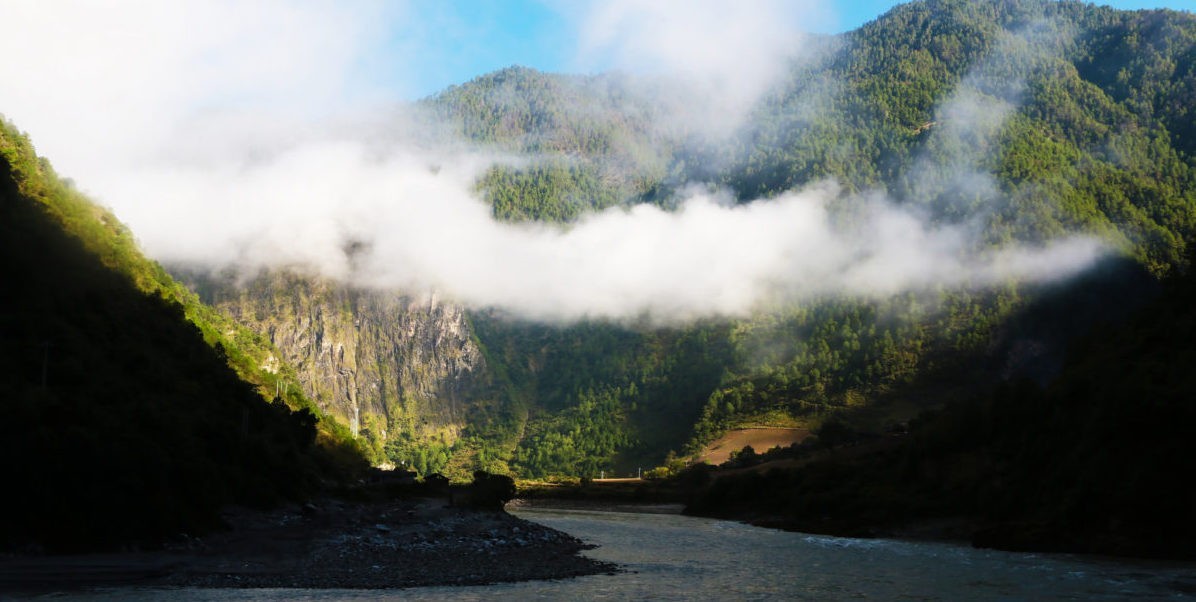Thuong Kon Tum dam, which is built in the Dak Snghe River watershed, is one of the biggest hydropower projects in the basin of the Se San river. The effect of the dam is still questionable but it raises concerns about environmental impacts as the project will submerge more than 382 hectares of watershed protection forests in Kon Tum province and divert water into the Tra Khuc river in Quang Ngai province.
Reservoirs or protection of forests?
From highway 676 looking down on the Dak Snghe river (Kon Plong district, Kon Tum province), the eyecatching scenery is the deep green forests with a rich ecosystem. These watershed protection forests are very condensed with many large trees.
According to a 2007 survey by the Institute of Tropical Biology, the Kon Plong forest community with an area of over 65,00 ha, is located in a mountainous ecological area with a diverse forest community of 644 species of plants.
This area is also the habitat of many species of birds, mammals, reptiles included in the world’s red list.
The Thuong Kon Tum dam is built in the catchment of the Dak Snghe river where it still maintains top coverage among watershed forests of the country. This area plays an important role in the water protection and regulation for the downstream of the Se San river system.
According to the environmental impact assessment (EIA) of the project, 382 of 414 hectares of natural forest that is usage-converted to build the reservoir, is actually forest that protects the watershed.
Therefore, the construction of a dam will adversely affect not only the ability of protection and the water regulation of the Se San River system, but also the East Truong Son rivers as well as eco-tourism potentials of the Mang Den plateau.
With the installed capacity of 220 MW, the Thuong Kon Tum dam will generate 1.094 million kWh annually, but occupies 414 hectares of natural forest and 135 hectares of agricultural land of 154 local households.
The tunnel of Thuong Kon Tum dam which diverts Se San river’s water to another province is being constructed (Photo: Thien Y)
The future dry rivers?
Thuong Kon Tum is the final dam of “the energy ladder” on the Se San river. It gets water from the Dak Snghe river and divert to the Tra Khuc river with a flow of 11.89m3/s, instead of discharging water to the Dak Bla river, one of three major tributaries of the Se San river.
The Dak Snghe river accounts for over 35% of the total water volume of the Dak Bla river which is the major water supply for the Kon Tum city.
When the Thuong Kon Tum dam is completed, the Dak Snghe watershed will become a 7 square kilometers lake, with active capacity of nearly 150 million cubic meters of water.
Water diversion will help the investor (Vinh Son-Song Hinh JSC Co.ltd) take advantage of the height of the water column from the reservoir to the turbines to increase engine power, but it also raises the concerns that it could be “killing” the rivers of Dak Snghe, Dak Bla in the dry season and the downstream areas such as Kon Plong, Kon Ray districts and Kon Tum city.
Nguyen Thanh Cao, chairman of the Union of Science and Technology Associations of Kon Tum province, said that the water diversion to the Tra Khuc river would dry up a section of 40 kilometres of the Dak Bla river, and make a negative impact on downstream biodiversity and livelihoods. There are only small streams along this river section, can not contribute enough water for the Dak Snghe river in the dry season. When the upstream reservoir finishes, this river section will be in danger of becoming “dead flow”.
According to a 2012-released research by the Institute of Development and Consultant and the Union of Science and Technology Associations of Kon Tum, the water diversion by Thuong Kon Tum dam will reduce about 7.7% of the flow of the Se San river, and a total capacity of 321 million kWh from other hydropower plants on the same river like Ialy, Se San 3, Se San 3A and Se San 4 as well. Consequently, the water quality and the habitat of hundreds of thousands of people downstream will be seriously affected.
Dr Dao Trong Tu, senior expert of Vietnam Rivers Network, emphasized that Vietnam had to pay a lot for the construction of the diversion projects such as Dak Mi 4 hydropower plant (in Quang Nam province) or An Khe – Kanak dam (in Kon Tum province)…
Beside the weather, inter-basin water diversion projects is a key factor for severe drought in some areas in the Central Highlands in the past few years.
“The river is the source of life of millions of people, diverting water from this basin to another should be prohibited,” Tu said.
This is part 2 of 3, in the author’s “Sorrow of Dams” series. See Part 1.
This story was produced by a local journalist with support from The Mekong Eye and Mekong Matters Journalism Network and is published under a pseudonym at the request of the journalist. The journalist and their outlet retain full editorial and copyright control.
Lead Photo: The flow of Dak Bla river in danger of becoming “dead flow” because of the water diversion dam (Photo: Thien Y)






